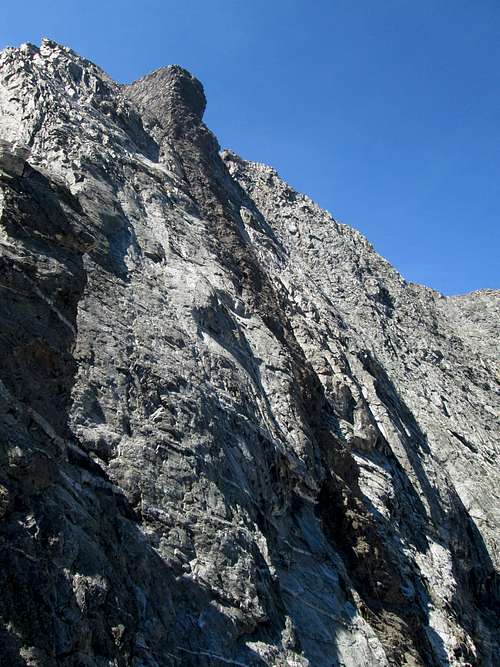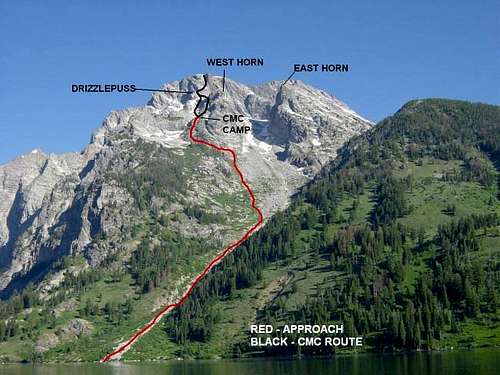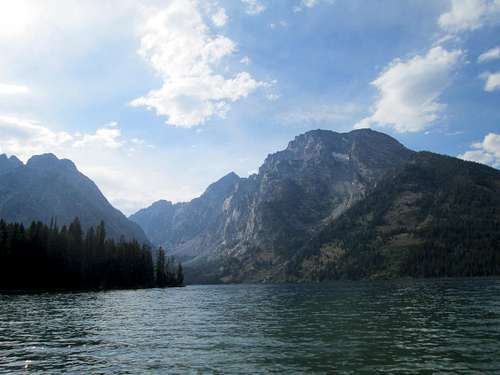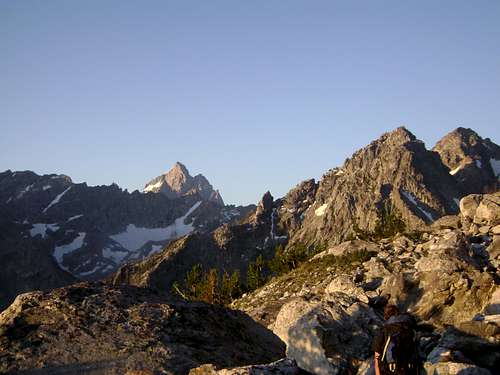|
|
Mountain/Rock |
|---|---|
|
|
43.83500°N / 110.776°W |
|
|
12605 ft / 3842 m |
|
|
Overview

Mount Moran in October 2005
Photo by Biglost
As you arrive in Grand Teton National Park from the north, Mt. Moran dominates the view. In fact, when driving south from Yellowstone, Mt. Moran is often mistaken for the Grand Teton by tourists upon seeing the Teton range for the first time. Unlike the other peaks which stand together in the middle of the range, Mt. Moran appears to stand alone, guarding the northern side of the Tetons.
Mt. Moran is named for Thomas Moran, a famous frontier landscape artist, who was the friend and colleague of Dr. Ferdinand D. Hayden, the noteworthy surveyor of the west in the late 1800s.
Mt. Moran was first ascended by LeGrand Hardy, Ben C. Rich, and Bennet McNulty on July 22, 1922 via the Skillet Glacier. On November 21, 1950, a DC-3 with 21 people aboard crashed into the mountain during a snowstorm at the 11,200 foot level above the Skillet Glacier, killing everyone including 7 children. The wreckage and the bodies remain there to this day and climbers are reminded not to disturb the gravesite.
CLICK HERE TO VIEW THE SUMMIT REGISTER ARCHIVE: This site contains a collection of digital images of the Grand Teton National Park Summit Register Archive including the register for Mount Moran. The summit registers were maintained from about the late-1920s into the 1980s and they form a unique repository of Teton climbing history.
All the routes to the summit are technical, the most noteworthy of which will be described later. Whichever the route, Mt. Moran is a spectacular peak offering an entire season of mountaineering challenges.
Getting There
Mt. Moran is located in the northwest corner of Wyoming in Grand Teton National Park. Most climbs are approached from Leigh Canyon or the Falling Ice Glacier gulch via the Jenny Lake area. From Jackson, Wyoming drive 12 miles north on Hwy 191 to Moose Junction. You will enter the park during the first 3 miles. Turn left (west) on Teton Park Road and drive approximately 9 miles to the South Jenny Lake Junction. Follow the signs to the String Lake picnic area.
Please refer to the left side-bar for approaches to the specific routes.
Noteworthy Routes
With the easiest route being 5.4 Grade III, and it's remoteness, this mountain should not to be taken lightly. The most famous route is the Direct South Buttress which is included in the Fifty Classic Climbs of North America by Steve Roper and Allen Steck. Here are some of the more noteworthy routes with first ascent (FA):
The CMC face of Mount Moran seen from Drizzlepuss, the crux of the CMC route. Photo taken by Jackson Herring AKA Panama Red
CMC Route: 5.5, Grade III. The most popular route to the summit offers a wonderful high camp site, a 1500 foot scramble, then a 1000 foot ascent of steep slabs along a vertical black dike. In addition, there is a technical pitch which must be led on the descent to gain the top of Drizzlepuss on the way back to the CMC camp. This pitch is 5.7 or 5.5 depending on the variation, and is the most exposed section of the entire route. The CMC route is normally climbed in 3 days. Day 1 is the approach to the high camp (4-6 hours). The summit day is usually between 10 and 14 hours round trip. Hike out on day 3. Due to the long duration and relative remoteness of this mountain, the CMC route on Mount Moran is considered the most difficult standard route in the Tetons. The CMC name is from the Chicago Mountaineering Club whose members Paul Petzoldt, Joseph Hawkes, Earl Clark, and Harold Plumley, made the first ascent of the route on June 25, 1941.
The first ski descent of the CMC route on Mt. Moran was by Doug Coombs, Bill Dyer, and Kent McBride on May 16, 2002. (Courtesy of Dave Hodge)
Direct South Buttress: 5.7 A3 Grade IV or 5.12 Grade V. Considered a Teton classic and a test piece of Teton mountaineers. 14 pitches. FA Richard Emerson, Don Decker, Leigh Ortenburger; August 30, 1933. First Free Ascent by Stan Mish and Hal Gribble on July 3, 1979. Outstanding trip report on the Direct South Buttress by nerdom.
To get to the base of the Direct South Buttress: Use a canoe to paddle across String Lake then portage to Leigh Lake where you will then paddle to the inlet at the entrance of Leigh Canyon. There will be a nondescript path which can be followed on the north side of the creek for the next mile and a half to the talus slope below Laughing Lion Falls. (Alois Smrz)
Skillet Glacier: 5.4, Grade III, Steep Snow/Ice. This is a year-round snow/ice climb with an additional rock section. See overview section for first ascent.
Here's a video of a climb and ski/snowboard descent of the Skillet Glacier in February 2009: Skillet Glacier Video on YouTube.
Northeast Ridge: 5.4 Grade II. Another moderate route to the summit but with a tougher approach. FA Albert Ellingwood and Carl Blaurock on August 19, 1924.
South Buttress Prow: 5.12a/b, Grade V. This route was established on September 29, 2006 by Hans Johnstone, Greg Collins, and Bean Bowers. Supposedly, the highlight of this climb is the 5.12 a/b crux which is a 100-foot splitter crack. Source: Rock and Ice Magazine, Issue 156, January 2007.
Sources:
A Climbers Guide To The Teton Range, by Leigh N. Ortenburger and Reynold G. Jackson
Teton Classics, by Richard Rossiter
Martin Cash
Dave Hodge
Red Tape
Mt. Moran is located inside Grand Teton National Park. There is a $25.00 entrance fee to the park which will also get you into Yellowstone (Good for 7 days). See info below for other entrance fees. No permits or fees are required to climb; however, a check-in with the Jenny Lake Ranger Station is recommended. Permits are needed for backcountry camping if using a high camp. Free permits are available at the Jenny Lake Ranger Station on a first come, first served basis. A limited number of permits can be made in advance by submitting your request in writing to the address or FAX number below. Reservations may be made as early as January 1 and are accepted up to May 15. Although the permit is free, there is a $15.00 non-refundable reservation fee. For more information call (307) 739-3397 or (307) 739-3309. Even though you have a reserved permit, you must pick up your permit in person by 10:00 am the morning of your trip or they will make it available to others. Grand Teton National Park
Grand Teton National ParkPermits Office
P.O. Drawer 170
Moose, WY 83012
FAX: (307) 739-3438
ENTRANCE FEES
Vehicle single entry $25.00 for 7 Days, $12.00 per person for single hiker or bicyclist, or $20.00 per motorcycle. You may also purchase an "America The Beautiful Federal Lands Recreational Pass" for $80.00 which is good for entrance to all National Parks, National Forests, BLM, US Fish & Wildlife, and Bureau of Reclamation sites for one year from date of purchase. If you're disabled, you may want to get an Access Pass which are free and good for a lifetime. If you're 62 years of age or older, a Senior Pass can be purchased for $10 and they're also good for a lifetime. Click here for more info on fees and passes. Existing National Park Passes and Golden Age/Access/and Eagle Passes will be honored until they expire. (Info courtesy of SP Member Sequoia)
BACKCOUNTRY REGULATIONS
When To Climb
June through early September is considered the summer season. July is the driest summer month while June is the wettest. However, that is an average over several years. It can storm and rain for days on end during any month. Like typical Rockies weather, the Tetons are notorious for violent afternoon thunderstorms, so get an early start. Plan on being off the mountain by early afternoon. However, it has also been known to storm at any time of the day including early in the morning. Sometimes the weather clears and high pressure moves in for several days of storm-free climbing. Check here for current weather conditions.Mt. Moran is also climbed in the dead of winter by experienced winter mountaineers. The first winter ascent was via the Northeast Ridge on December 19, 1966 by Tom Stevenson, George Lowe, Mike Lowe, Dennis Caldwell, Tom Spencer, Court Richards, and Bill Conrod. Check here for current winter and avalanche conditions.
Camping
Grand Teton National Park has five campgrounds all on a first come, first served basis. Jenny Lake campground has 49 sites for tents only and fills very fast. Other campgrounds: Gros Ventre - 360 sites, Signal Mountain - 86 sites, Colter Bay - 350 sites, Flagg Ranch - 175 sites, and Lizard Creek - 60 sites. Colter Bay and Flagg Ranch each have over 100 full RV hookup sites.All backcountry camping must have a permit as described above. The best backcountry site for a high camp is the CMC campsite, located at 10,000 ft at the top of Falling Ice Glacier Gulch and below Drizzlepuss. The maximum stay at the CMC campsite is two nights. Water can be found in a spring to the south of the CMC campsites in the wide gully. In late season, the spring yields little water. You can also get water at the base of the Falling Ice glacier via a 20 minute traverse north of the CMC campsites.
The best option to camping before your climb is to stay at the American Alpine Club's Climber’s Ranch located 7 miles past Moose Junction on Teton Park Road. The Ranch offers very rustic accommodations for only $20/per night. Very rustic means you bring your own bedding, mattress, etc., and you will be sharing a cabin with other climbers. Showers and a cooking area are available. Lodging is on a first come, first served basis but reservations are accepted. You can make an online reservation here or call (307) 733-7271 between June 1 and September 30. You do not have to be a member of the American Alpine Club to stay there; however, the AAC rate is only $10.00/night.
ATTN: Manager
P.O. Box 57
Moose, WY 83012
Email: gtcr@americanalpineclub.org
Mountain Conditions
All routes are in an alpine environment. Expect any type of conditions any time of the year, including, storms, snow, and ice. Temperatures can vary from moderate to sub-freezing. July is considered the best month to climb with the least average precipitation. Rock fall is very common in the Tetons and Mt. Moran is no exception. Trailhead elevations are approximately 6800-7000 ft and tree line is at approximately 9000 ft. The Jenny Lake Ranger Station is the headquarters for Teton climbing. Call the ranger station at (307) 739-3343 (summer) or (307) 739-3309 (winter) for current conditions.Here is a great link for up-to-date route conditions on Mt. Moran: www.TetonClimbing.blogspot.com.

Live webcam view of Mt. Moran. Click to enlarge.
Due to weather or technical issues, the mountain may not always be in view.
Webcam by www.JacksonHoleWebCams.com

Sunrise on the Tetons. Jackson Lake rarely this calm. The tip of Moran gleaming white in the morning sun. Sublime..........October 8, 2005
Photo by Biglost
External Links
- American Alpine Club Climber's Ranch
A great place to stay in Grand Teton National Park. The ranch offers very rustic accommodations for only $8.00/night. It is within walking distance to the central peak's trailhead. The nice thing about staying at the Ranch is the manager and most who stay there are climbers who have a lot of good beta on the peaks and the conditions.
- Grand Teton National Park official site
- Grand Teton National Park Weather
- Jackson Hole, Wyoming Chamber of Commerce Site
Events, dining, lodging, and shopping in Jackson Hole, Wyoming.
- Classic Climbs of North America CD
Gary and Lynn Clark's CD of classic climbs of North America. Of interest is the Mt. Moran's South Buttress route with a topo and 35 fantastic photos of the route. You have to buy the CD to see the pics, but it's worth it.
- Way-Wired Mountaineers
A Teton climbing and skiing website with information, routes, photos, and stories of Teton climbing.
- Exum Mountain Guides
Exum is probably one of the best guide services in the country.
- Jackson Hole Mountain Guides
Outstanding guide service for the Tetons and other great peaks of the west.
- Trip Report by Jesse Hull
Nice trip report of an unsuccessful attempt with good photos.
- Trip report by Paul Doherty
Nice trip report of a successful attempt with good photos.
- Team Arp climbs CMC July, 2004







